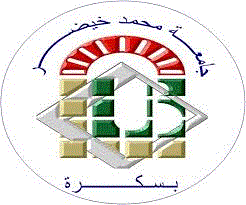| Titre : | Integrating GANs for Enhanced Data Augmentati in AI-Driven Mobile Skin Cancer Detection |
| Auteurs : | hana Belaala, Auteur ; ayaterrahmane Tahri, Auteur ; Amani mariya Namane ; Abir Belaala, Directeur de thèse ; Abd El Mounène Zerari, Directeur de thèse |
| Editeur : | Biskra [Algérie] : Faculté des Sciences Exactes et des Sciences de la Nature et de la Vie, Université Mohamed Khider, 2024 |
| Format : | 1 vol. (77 p.) / ill., couv. ill. en coul / 30cm |
| Langues: | Anglais |
| Mots-clés: | Skin cancer, Computer Aided Diagnosis , AI, medical imaging, Pix2Pix, DieT transformer, ISIC2019, mobile application, Generative Adversarial Networks (GANs) |
| Résumé : |
Skin cancer represents a critical global health issue, with millions of new cases diagnosed annually. Early detection and accurate classification of skin lesions are essential for effective treatment and improved patient outcomes. Traditional diagnostic methods rely heavily on clinical expertise and invasive biopsies, which can be subjective and time-consuming. This thesis explores the development of an advanced, AI-driven diagnostic tool aimed at the rapid and accurate classification of eight types of skin lesions using dermoscopic and standard images. Leveraging the ISIC2019 dataset and advanced data augmentation techniques, notably Pix2Pix Generative Adversarial Networks (GAN ) technology, we address the common challenge of data imbalance. This enables the creation of a more representative and robust training dataset. Ourmodel employs state-of-the-art transformer technology, specifically Vision Transformers (ViT), to capture long-range dependencies and contextual information in images, surpassing the capabilities of traditional convolutional neural networks (CNNs). This thesis details the entire development process, from data collection and augmentation to model training and evaluation. We present the design and implementation of a mobile application that facilitates remote and early skin cancer detection, aiming to improve accessibility and reduce the burden on clinical workflows. The AI model demonstrates high accuracy, precision, recall, and F1-score across multiple skin lesion types, showcasing its potential to enhance diagnostic accuracy and efficiency. |
| Sommaire : |
1 Preliminaries and basic concepts 10 Introduction . ..........................................10 1 SkinCancer . .......................................10 1.1 TypesofSkinCancer . ..............................11 1.1.1 Melanoma . ..............................11 1.1.2 Nonmelanomaskincancer . .....................12 1.2 Diagnosisofskincancer . ............................12 1.2.1 TraditionalDiagnosticMethods . ...................13 1.2.2 ComputationalDiagnosticAdvances . ................14 2 ArtificialIntelligence . ..................................15 2.1 MachineLearning(ML) . ............................15 2.1.1 TypesofMachineLearningAlgorithms . ...............16 2.2 Deeplearning(DL) . ...............................18 2.2.1 Deeplearningprocess . ........................19 2.2.2 Typesofdeeplearning . ........................20 2.3 VisionTransformers(ViTs) . ...........................24 2.3.1 Componentsofvisiontransformers: . .................25 2.3.2 Typesofvisiontransformers . .....................26 Conclusion . ..........................................26 2 Relatedwork 28 Introduction . ..........................................28 1 RelatedScientificwork . .................................28 1.1 OurContributioninAImodel . .........................29 2 Existingsimilarmobileapplication . ..........................30 Conclusion . ...........34 3 AnalysisandDesign 36 Introduction . ..........................................36 1 Systemanalysis . .....................................36 1.1 Purposeoftheapplication . ...........................37 1.2 Functionalrequirement . .............................37 1.3 Non-functionalrequirement . ..........................38 1.4 Usecasediagram(systemanalysismodel) . ...................39 1.4.1 Identificationofactors . ........................41 1.4.2 Identificationofusecases . ......................41 2 Systemdesign . ......................................43 2.1 Globalarchitectureofthesystem . ........................44 2.2 DefinitionofUML . ...............................44 2.3 Dynamicaspect . .................................45 2.3.1 Sequencediagramofthe”Register”scenario . ............45 2.3.2 Sequencediagramofthe”Authentication”scenario . .........46 2.3.3 Sequencediagramofthe"applydiagnostic"scenario . ........48 2.4 Databasedesign . .................................49 2.4.1 Entity-AssociationModel . ......................49 2.4.2 Relationalmodel . ...........................50 2.5 Thenavigationmodel . ..............................50 Conclusion . ..........................................51 4 Implementation 53 Introduction . ..........................................53 1 Pix2PixGANdevelopment . ...............................54 1.1 OfflineStep . ...................................55 1.1.1 DevelopmentToolsandLibraries . ..................55 1.1.2 Datadescription . ...........................56 1.1.3 DataPreprocessing . ..........................56 1.1.4 SemanticSegmentation . .......................57 1.1.5 Dataanalysis . .............................58 1.1.6 Results: . ................................59 1.2 OnlineStep . ...................................60 1.2.1 Datadescription . ...........................60 1.2.2 GeneratingNewImages . .......................61 1.2.3 Results . ................................61 2 Deitarchitecturedevelopment . .............................62 2.1 Developmenttools . ...............................62 2.2 Datacollection . .................................63 2.3 DataPreprocessing . ...............................64 2.3.1 TrainingDataTransformations . ....................64 2.3.2 Validation/TestDataTransformations . ................65 2.4 Dataanalysis . ..................................66 2.4.1 Traininghyperparameters . ......................67 2.5 TestingResults . .................................67 2.5.1 Withoutpix2piximagegeneration . .................68 2.5.2 Withpix2piximagegeneration . ...................70 3 Mobileapplicationdevelopment . ............................73 3.1 Logo . .......................................73 3.2 Tools . ......................................75 3.3 Filesstructure . ..................................76 4 Overviewoftheapplication . ...............................77 4.1 Startscreens . ...................................77 4.2 Homepage . ...................................77 4.3 PaymentGUI . ..................................78 4.4 Signuppage . ..................................79 4.5 Loginpage . ...................................80 4.6 ApplyDiagnosispage . ..............................82 4.7 Sharingexperiencespage . ...........................84 4.8 Previousdiagnosisresultspage . .........................84 4.9 Dermatologistpages . ..............................85 General conclusion 87 |
| Type de document : | Mémoire master |
Disponibilité (1)
| Cote | Support | Localisation | Statut |
|---|---|---|---|
| MINF/890 | Mémoire master | bibliothèque sciences exactes | Consultable |





